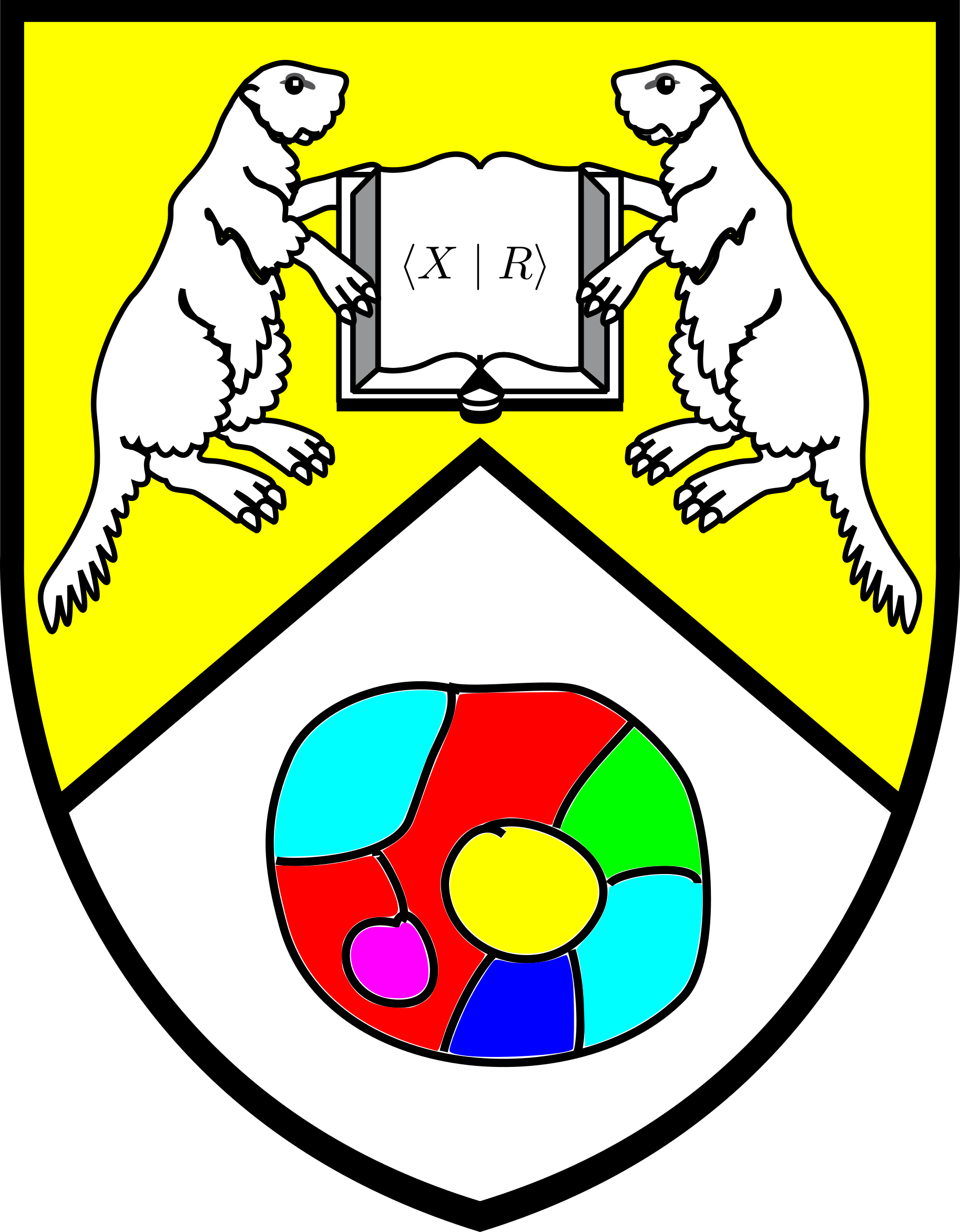Section 2.1 Quasi isometries
Back in Section 1.5 we saw that a choice of generating set \(G = \gen A\) gave rise to a Cayley graph \(\cay A G\) which in turn endows \(G\) with a metric \(d_{\cay A G}\text{.}\) However, the subject matter in the previous sections should have reinforced the fact that there should be no expectation that such a metric be canonical for the group. A surprisingly successful strategy has been to simultaneously consider all possible metrics on \(G\) that arise from choices of finite generating sets. This motivates the following definition.
Spoiler: Quasi isometry is an unreasonably effective tool in group theory.
Definition 2.1.1. Quasi isometric embedding.
Let \((X,d_X)\) and \((Y,d_Y)\) be metric spaces. We say a function \(f:X \to Y\) is a \((K,C)\)-quasi isometric embedding where \(K,C\) are strictly positive real numbers and we haveWe can always make the numbers bigger.
Lemma 2.1.2.
If \(f:X \to Y\) is a \((K,C)\)-quasi isometric embedding and \(K'>K, C'>C\) then \(f\) is also a \((K',C')\)-quasi isometric embedding.
Proof.
Often we will omit the bounds \((K,C)\) and simply talk of a quasi isometric embedding, i.e. we'll say that \(f:X \to Y\) is a quasi isometric embedding if there exist numbers \((K,C)\) that satisfy the requirement of Definition 2.1.1.
Definition 2.1.3. Coarsely dense.
Let \((X,d_x),(Y,d_y)\) be metric spaces and let \(f:X \to Y\) be a quasi-isometric embedding. We'll say its image is \(D\)-coarsely dense if there is some \(D>0\) such that for every \(y\in Y\) there exists some \(x_y \in X\) such that:
As before, we will say that the image of a quasi isometry is coarsely dense, if it is \(D\)-coarsely dense for some \(D>0\text{.}\) In this business, the actual parameters don't always matter.
Definition 2.1.4. Quasi isometry.
Let \((X,d_X),(Y,d_Y)\) be metric spaces and let \(f:X \to Y\) be a quasi isometric embedding. We say that \(f\) is a quasi-isometry if there exists a quasi isometric embedding \(g:Y \to X\) called a quasi-inverse such that there is some number \(D\) such that:
- For all \(x \in X\text{,}\) \(d_X(x,g(f(x))\leq D\text{,}\) and
- For all \(y \in Y\text{,}\) \(d_Y(y,f(g(y))\leq D\text{.}\)
Another way to say this is that the compositions \(g\circ f\) and \(f\circ g\) are \(D\)-close to the identity.
We will finally state two results and leave proofs and examples as exercises.
Proposition 2.1.5.
Let \(A,B\) be two different finite generating sets of a group \(G\text{,}\) then the Cayley graphs \(\cay A G\) and \(\cay B G\) are quasi isometric.
Proof.
Proposition 2.1.6.
Let \((X,d),(Y,d)\) be metric spaces. Prove that if \(f:X \to Y\) is quasi isometric embedding with a coarsely dense image, then \(f\) is a quasi-isometry.
Proof.
Exercises 2.1.1 Exercises
1.
Prove Lemma 2.1.2.2.
Show that quasi isometry gives an equialence relation between metric spaces.
3.
The following question is stated in the context of function \(f:X\to Y\) between metric space.
By a linear growing function we mean a linear function \(\ell(x) = mx +b\) where \(m,b \in \RR\) and \(m>0\) (like in Calculus 1.) Show the following:
- If there is a linear growing function \(\ell_r(x)\) such that\begin{equation*} d_Y(f(x),f(y)) \leq \ell_r(d_X(x,y))\text{,} \end{equation*}then there is a linear growing function \(\ell_l(x)\) such that\begin{equation*} \ell_l(d_Y(f(x),f(y))) \leq d_X(x,y) \end{equation*}
- Show that if there are linear growing functions \(\ell_1,\ell_2\) such that for all \(x,y \in
X\) we have\begin{equation*} d_X(x,y) \leq \ell_1(d_Y(f(x),f( y))) \end{equation*}and\begin{equation*} d_Y(f(x),f(y)) \leq \ell_2(d_X(x,y)), \end{equation*}then \(f:X\to Y\) is a quasi isometric embedding.
4.
Let \(\Gamma\) be a graph and let \(V(\Gamma)\) be it's vertex set. Let \(V(\Gamma)\) be equipped with the metric induced by \(\Gamma\text{.}\) Suppose every edge has length \(1\) and consider a retraction
where each edge interior is mapped to some adjacent vertex. Show that \(r\) is a quasi-isometry.
5.
Prove Proposition 2.1.5.
Hint: Look back at Exercise 1.6.1.5
Other hint: In this case you are considering the a group \(G\) with two metrics \(d_A\) and \(d_B\) (from two finite generating sets of \(G\)) and function you want to use is the identity. Show that there are linear functions \(\ell_1,\ell_2\) such that
for all \(x,y \in G.\)
6.
Prove Proposition 2.1.6.
Hint: Although the statement of Proposition 2.1.6 doesn't have any parameters, you should start by fixing parameters.
Other hint: for a quasi-inverse define \(g(y)\) to be some \(x\in X\) such that \(d_Y(f(x),y)\) is minimal, or at least unifomly bounded for all \(y\) (this is where \(D\)-coarsely dense becomes important.)
7.
Prove that with the standard Euclidean metric that the mapping
Is a quasi-isometric embeding, but not a quasi-isometry.
8.
Consider the graph \(\Gamma= \cay{\{1\}} \ZZ\text{,}\) i.e. the real line with vertices at integer points. Let's conisider what happens when we change the lengths of edges.
- Fix \(0\lt a\lt b\in \RR \text{.}\) Show that if for each edge \(e\) of \(\Gamma\) we randomly change its length to some number \(a\lt\ell_e\lt b\) then the resulting metric space \(\Gamma'\) is quasi-isometric to \(\Gamma\text{.}\)
- Show that if we let the length of edges be any \(0 \lt l_e \leq 1\text{,}\) then the resulting graph may not be quasi-isometric to \(\Gamma\)
Hint: if edges schrink too much maybe the graph will have finite diameter.
